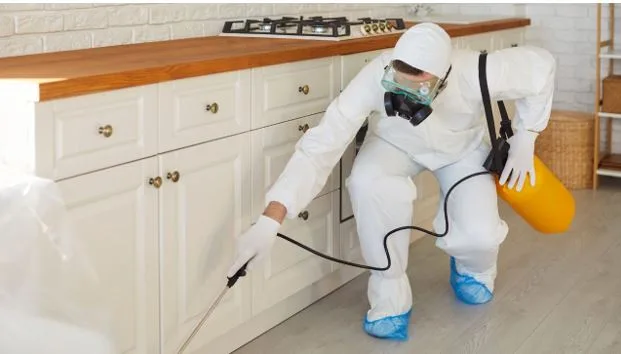How to Spot Pest Problems Before Buying a Home
Buying a home is one of the biggest financial decisions most people will ever make. You research neighborhoods, calculate mortgage payments, and picture where the couch will go. What often gets overlooked? The possibility that you might be inheriting someone else’s pest problem.
According to the National Pest Management Association, approximately 29% of American homes experience a pest infestation at any given time. That means nearly one in three homes you tour could have unwanted roommates hiding behind the walls.
With some knowledge and attention to detail, you can spot many warning signs before signing on the dotted line. Here’s what to look for during walkthroughs and why a professional pest inspection might be one of the smartest investments you make.
Why Pest Problems Matter More Than You Think
Pest issues aren’t just creepy or inconvenient. They can signal deeper property problems and lead to significant expenses.
Termites alone cause over $5 billion in property damage annually in the United States, and most homeowners insurance policies don’t cover that damage. Rodents chew through electrical wiring, creating fire hazards. Cockroaches and mice spread bacteria and allergens that affect indoor air quality.
Discovering a pest problem after closing means you’re responsible for treatment costs that can run into the thousands. A little detective work during the house-hunting phase saves major headaches later.
Warning Signs You Can Spot During a Walkthrough
You don’t need to be a pest control expert to notice red flags. Keep these indicators in mind as you tour homes.
Droppings and Evidence of Activity
One of the most obvious signs of pest activity is droppings. Mouse and rat droppings are small, dark pellets typically found near food sources, inside cabinets, along baseboards, and in attics or basements. According to the CDC, rodent droppings carry harmful bacteria and transmit diseases, making them both a health concern and a clear indicator of infestation.
Cockroach droppings range from small specks resembling coffee grounds to larger cylindrical pellets. Finding droppings during a showing is a significant red flag.
Take a flashlight and don’t be shy about opening cabinet doors, checking behind appliances, and looking in corners. If the current owners haven’t cleaned up evidence of pests, there may be an ongoing problem.
Gnaw Marks and Structural Damage
Rodents have teeth that never stop growing, so they constantly gnaw on things to keep them filed down. Look for bite marks on:
- Baseboards and door frames
- Cardboard boxes in garages or storage areas
- Wooden beams or trim work
- Food packaging in pantries
Mice leave smaller, scratchier marks, while rat damage is larger and more pronounced. Gnaw marks on electrical wiring are particularly concerning since rodents chewing on wires cause house fires.
Termite damage is harder to spot because these insects work from the inside out. Tap on wooden window frames, door jambs, and exposed beams. Hollow-sounding wood may have termites feeding inside. Paint that appears bubbled or cracked can indicate termite activity beneath the surface.
Mud Tubes on the Foundation
Subterranean termites build pencil-sized mud tubes to travel between their underground nests and the wood they’re feeding on. These tubes protect them and maintain the moisture they need to survive.
Check foundation walls, both inside and outside, in the garage, and in crawl spaces. Mud tubes running up from the ground are one of the most reliable indicators of termite infestation.
Unusual Odors
Pests leave distinctive smells. A musty, ammonia-like odor can indicate rodent infestation from urine and droppings in hidden spaces. Cockroaches produce an oily, musty smell that intensifies as populations grow.
Trust your nose during a walkthrough. If something smells off and you can’t identify the source, investigate further.
Physical Damage and Entry Points
Walk the exterior of the home and look for potential entry points. Gaps around pipes, cracks in the foundation, torn window screens, and openings where utilities enter the building can all serve as pest highways.
Inside, check for holes in walls, particularly near plumbing or behind appliances. Any gap larger than a quarter inch could invite mice, and rats need only a half-inch opening to squeeze through.
Wood mulch piled directly against the foundation or tree branches touching the roof are conditions that attract pests even if an infestation isn’t currently present.
Room-by-Room Checklist
Different areas attract different pests. Focus your attention accordingly.
Kitchen and Pantry
Prime territory for ants, cockroaches, and rodents drawn to food sources. Open cabinet doors and look in back corners. Check under the sink for moisture and pest activity. Any droppings or gnaw marks here deserve attention.
Basement and Crawl Space
Dark, damp spaces are pest magnets. Look for standing water, moisture damage, droppings, nests made from shredded material, and mud tubes along the foundation.
Attic
Rodents and wildlife often enter through attic spaces. Look for droppings, nesting materials, disturbed insulation, and gnaw marks on wooden rafters.
Garage
Garages often have gaps that make pest entry easy. Check along the garage door seal, around the door into the house, and in storage areas. Cardboard boxes attract pests looking for nesting material.
The Value of a Professional Pest Inspection
While your observations matter, a professional pest inspection catches what untrained eyes miss. Licensed inspectors know exactly where to look and can identify not just current infestations but also conditions that make future problems likely.
A standard home inspection doesn’t always include a thorough pest assessment. Most inspectors note obvious damage but may not conduct the specialized examination needed to find termites or carpenter ants.
Zunex Pest Control recommends that buyers request a separate pest inspection, especially where wood-destroying insects are common. For VA loans and in certain states, a pest inspection is required before mortgage approval.
Pest inspections typically cost $75 to a few hundred dollars. Compare that to the thousands you might spend treating an infestation, and the value is clear.
Questions to Ask During the Buying Process
Don’t rely solely on what you see. Ask direct questions:
- Has the home ever had a pest problem? What was done to address it?
- Is there an existing pest control contract? Can you see records?
- When was the last termite inspection, and what were the results?
Sellers aren’t always required to disclose past pest problems, and requirements vary by state. However, pointed questions can reveal information that wasn’t initially volunteered.
What to Do If You Find Signs of Pests
Discovering evidence of pests doesn’t necessarily mean you should walk away. It depends on the type and severity of the problem.
An active termite infestation is serious but treatable. The key questions become: How extensive is the damage? What will treatment cost? And who will pay for it?
You can often negotiate with sellers to have the problem professionally treated before closing, request a credit toward treatment costs, or reduce your offer. Having an inspection report from a residential pest control company gives you documented evidence to support your negotiating position.
Some problems are deal-breakers. Severe structural damage from years of untreated termite activity might make a home a poor investment regardless of price. Professional inspections help you understand whether you’re looking at a minor issue or a major problem affecting the home’s safety and value.
Prevention Starts Before Move-In
If you purchase a home, don’t wait for problems to develop. Scheduling a professional inspection shortly after moving in establishes a baseline and catches issues that might have been missed.
Regular preventive treatments from a reputable provider protect your investment. Companies like Zunex Pest Control that understand local pest pressures can tailor their approach to your specific environment rather than applying one-size-fits-all solutions.
The goal is never having to deal with an infestation in the first place. Proactive attention goes a long way toward keeping your new home pest-free.
Final Thoughts
Buying a home involves enough stress without discovering you’ve also purchased a rodent colony or termite buffet. Take time to look carefully during showings, ask the right questions, and invest in a professional pest inspection.
The signs are often there if you know what to look for. Droppings, gnaw marks, mud tubes, unusual odors, and structural damage all tell a story. Learning to read those signs protects your wallet and your peace of mind.
A home should be comfortable and safe, not shared with unwelcome pests. Do your homework before closing, and you’ll be much more likely to enjoy your new home without unpleasant surprises.




